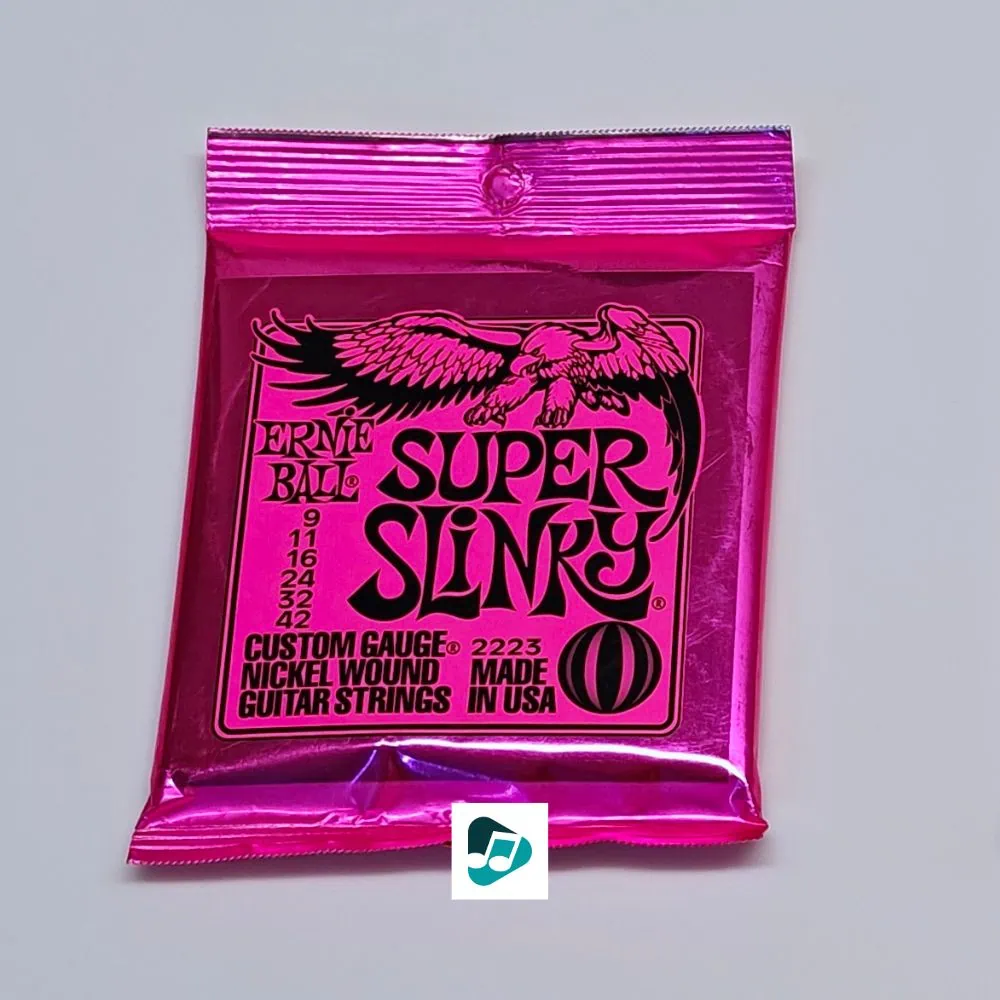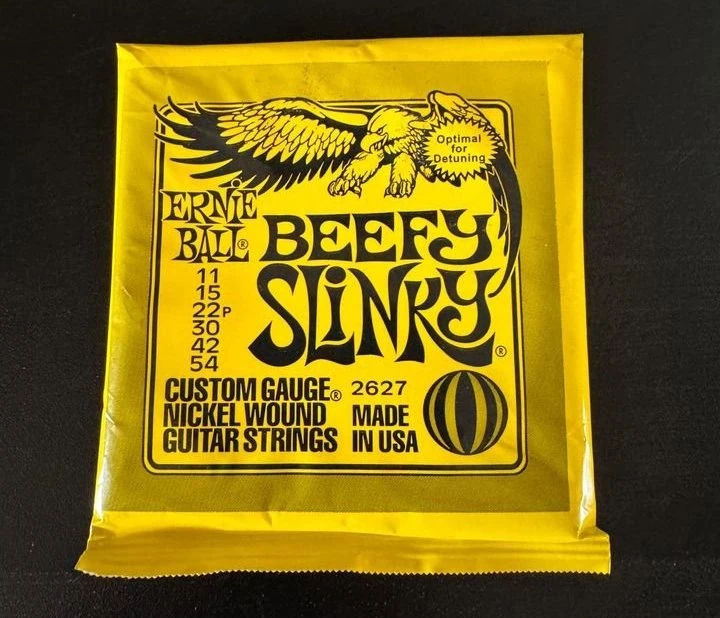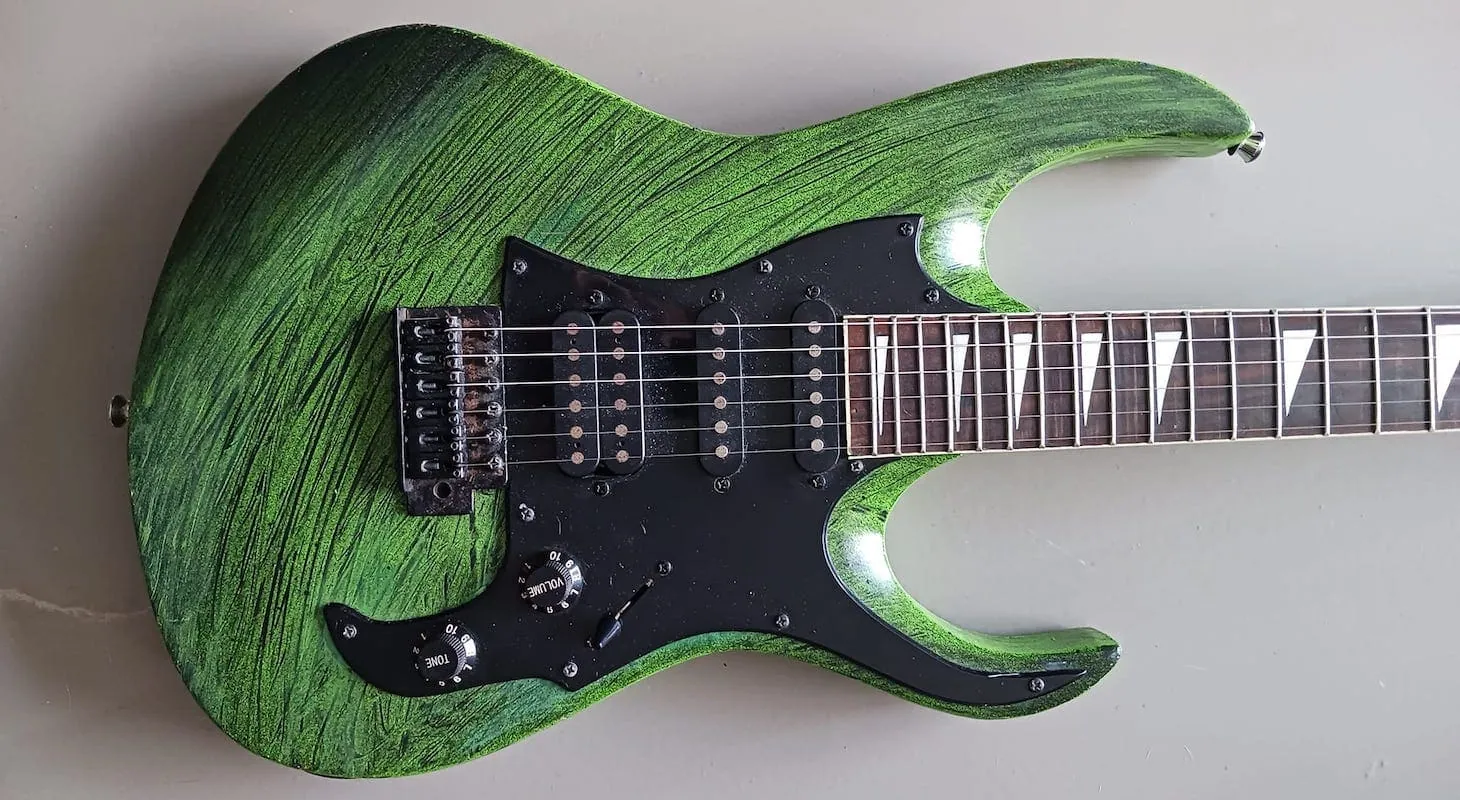Picking which gauge of guitar strings to play can be a bit of a challenge, especially for beginners.
Deciding if you need to go heavy, light, or maybe even a mix of both has an effect on both your tone and your playing. There are benefits and drawbacks to both light and heavy strings.
To help you choose which gauge to use, you can look at what some famous guitar players use. This is probably the easiest way to start your journey towards emulating their signature tone.
I personally started playing heavier strings because my favorite guitarist, Dan Hawkins of The Darkness, used them. Let’s find out what strings your favorite guitar players used!
Table of Contents
Difference in String Gauges
I prefer to use heavier strings. I’ve been a devoted user of the Ernie Ball Beefy Slinky 11-54 gauge for about ten years now.
Part of that is my tendency to play very hard with aggressive vibrato, so heavier strings compensate for my more aggressive technique. I also usually play in Eb tuning, so the increased string tension prevents the strings from feeling too light or “floppy”.
I also find the thicker strings, particularly across G, D, A, and E, have a thicker, more baritone-like tone, with improved note definition in chords.
However, many guitar players prefer lighter strings for improved playability and a more subtle touch.
Light Gauge
Let’s have a look at the light side of the string gauge first.

Jimmy Page
One of the pioneers of rock ‘n roll, Jimmy Page infamously used banjo strings on his high E string. This is because guitar strings didn’t come in such light gauges back then, and that is what Page preferred.
In the ‘70s, however, guitar strings got lighter, and Page played .009 and .008 gauge strings on his electric guitars.
Jimi Hendrix
When Hendrix set the world alight, he strung his upside-down Stratocaster with pure nickel strings, carefully selecting each string gauge to his own preference.
In order of lightest to heaviest, Hendrix used: .010 / .013 /.015 / .026 / .032 / .038.
Joe Satriani
When you’re an incredible shredder like Joe Satriani, you need strings that allow you to go as fast as possible without getting in the way of your playing.
Satriani’s otherworldly technique is made easier by his exclusive use of lighter strings. The reduced tension allows Satriani to use a lighter touch, increasing his playing speed.
That is why Satch often played .009 gauge in E standard tuning. More recently, however, he’s started playing with his guitars tuned down a semitone (half step down in Eb), and switched to .010 gauge.
Steve Vai
David Lee Roth’s answer to Eddie Van Halen is known for his guitar pyrotechnics and flame-shaped instrument. What else can you expect from one of Satriani’s students, but to use a similar gauge of strings?
Steve Vai has stuck with .009 gauge throughout his long career. It isn’t uncommon for him to switch to .010 gauge, especially for heavier songs.
Eddie Van Halen
Considered by many to be the godfather of shred, Eddie Van Halen is also a light gauge player. For my money, the greatest player of all time.
Sticking with the .009 gauge trend, although not a standard set. Van Halen went lighter on the low end, with the low E being only .040.
Be careful of your picking and fretting technique when playing Van Halen songs, as Eddie often tuned to Eb, or even Drop Db.
John Frusciante
The on-off guitarist for The Red Hot Chili Peppers over the last few decades, it’s a bit surprising that, unlike his playing, there’s nothing too remarkable about his string selection.
Frusciante goes the fairly standard route with .010 – .046 gauge.
Billy Gibbons
Billy Gibbons’ tone is as thick and wooly as his beard. Known for thick, fuzzy riffs, ZZ Top guitarist, Billy Gibbons actually used to play heavier gauge strings.
After receiving some advice from none other than B.B. King, Gibbons switched to a lighter gauge. Ever since, Gibbons has used thin strings, relying on his playing technique for the density of his tone.
How light? .007 gauge light.
It just goes to show that you don’t need thick strings tuned all the way down to get a fat and heavy tone.
B.B. King
B.B. King’s wide, soaring bends were a hallmark of mid-century electric blues playing. Gibson actually released a signature set of strings based on King’s own specifications while the blues legend was still alive, a hybrid gauge set of .010 – .054.
However, B.B. King often shifted his sets of strings one down. He would put the A string in the E spot, the D string in the A spot, and so on. For the high E string, he would use, as many other players did, an ultra-light banjo string.
For the classic, feather-light B.B. King tone, you might want to look at .008 or .007 gauge strings with a low E string no heavier than .042.
Angus Young
Most young guitar players find themselves learning a few AC/DC riffs. I’m a huge Angus Young fan: I think his vibrato is among the best in the game.
He uses light .009 – .042 gauge strings to facilitate his wide vibrato and lightning-fast lead licks.
Brian May
Queen’s axeman uses a custom-built guitar and a sixpence instead of a guitar pick. That’s a huge piece of his unique, immediately identifiable guitar tone. Brian May goes for extremely light strings, beginning his career with .008 gauge banjo strings.
In recent years, May switched to .009-.042 gauge strings.
Peter Frampton
Peter Frampton’s jazz-influenced rock playing is best exemplified on Frampton Comes Alive, a seminal ’70s rock live album.
Peter Frampton preferred to string his Les Paul with .009-.042 gauge strings, typically relying on Ernie Ball Super Slinkys.
Joe Perry
The Aerosmith axeman is as well known for his offstage antics as his bluesy, groovy playing. Perry often deploys aggressive vibrato and bends, and has been known to play a six-string bass as if it was a regular guitar.
For most of his typical guitar playing – or as close as you can get with Joe Perry – he prefers Ernie Ball strings in either .008 gauge or .010, depending on the guitar.
John Mayer
The modern-day guitar hero John Mayer uses standard issue Ernie Ball Regular Slinky .010 gauge strings for his electric guitars. One notable exception is Mayer’s beloved black Stratocaster, which he strings with .011 gauge Ernie Balls.
On his acoustic guitars, Mayer prefers .013 – .056 80/20 Phosphor Bronze strings.
Tony Iommi
Black Sabbath’s lead guitarist, and the unquestioned lord and master of heavy metal riffage, lost the ends of the fingers on his left hand to an industrial accident.
To allow him to continue playing guitar, Iommi created thimble-like extensions for his mangled digits from wax. He also adopted drastic downtuning to D# standard and C# standard to minimize string tension on his Gibson SG.
The final step was to further remove lingering tension with ultra-light gauge strings. In D#, Iommi uses gauges .008 – .008 – .011 – .018 – .024 – .032.
On his C# guitars, Iommi goes a little heavier, with .009 – .010 – .012 – .020 – .032 – .042 gauge strings.
Heavy Gauge
Now we move to the heavy hitters on the beefier side of the strings gauge.

Zakk Wylde
The Ozzy Osbourne and Black Label Society axeman has been delivering punishing detuned riffs and lightning-fast leads for decades now.
Wylde’s monstrous tone comes from a combination of his terrifying technique and precise choice of gear. A Les Paul with EMG pickups and a cranked Marshall amp will only get you so far.
A huge piece of the Zakk Wylde tone puzzle is his use of custom gauge strings. His high strings are usually .010, .013, and .017, standard light gauge.
Then at the low end, Wylde goes for enormous tension: .036 on the D string, .052 on the A string, and .060 on the low E! This enables Wylde’s use of aggressive drop tuning, which can sometimes reach C#.
Kurt Cobain
Legendary Nirvana frontman Kurt Cobain helped to define the grunge sound during his career. Having a rather chunky tone, he certainly used the thicker string gauge to help produce his tone.
Cobain often switched between clean and dirty tones. To ensure minimal loss of volume and tone between the two options, he used heavier strings.
Kurt used a fairly standard .010 gauge at the top but beefed out the bottom with .052 gauge strings.
James Hetfield
When you’re in the biggest metal band in the world, and you’re known for fast and aggressive down picking, you want to go with heavy strings.
No wonder Metallica frontman, James Hetfield, normally plays .011 – .048 gauge strings. If you’re playing like Hetfield, you want your strings to sound good, and most importantly, not snap while you’re playing.
Slash
The top-hatted Guns N’ Roses guitar maestro often switches between chunky rhythm playing and furious, melodic solos.
Iconic not only for his look but also for his fast riffs and ripping solos – Slash has been writing heavy hitting riffs for over three decades now, and most of them have been written and played using sets of .011 – 48 gauge strings.
He preferred nickel wound Ernie Ball strings for most of his career. The slightly heavier tension on his high strings helps Slash get the most out of his ultra-precise bends.
Joe Bonamassa
The modern-day bluesman prefers heavy strings for his arsenal of vintage instruments. Bonamassa uses Ernie Ball Beefy Slinky and Power Slinky strings, either .011 – .048 or .011 to .052 on all his guitars.
He has used .010 gauge strings on his Stratocasters in the past, with the exception of any guitars in an open tuning.
Gary Moore
Arguably Ireland’s greatest guitar playing export, Gary Moore’s thick, overdriven Les Paul tone is the stuff of most guitarists’ dreams.
He used Dean Markley .010 or .009 gauge strings, preferring heavier strings when he switched to all-out blues playing in the late ’80s.
Dick Dale
You would think that the man who practically invented surf rock would go light to get that surf rock twang.
Instead, Dick Dale went the opposite route, the very opposite. Dale went with probably the heaviest gauge anyone has ever gone with: .016 – .060.
No wonder he played so close to the bridge. All I can say is that Dick Dale has the toughest fingers in music.
Stevie Ray Vaughan
A pioneer of blues-rock, Stevie Ray Vaughan was an incredibly talented guitarist. The Texan guitar legend is best known for his blues stylings, but he was a tremendously versatile player who once played sideman to David Bowie in the Let’s Dance era.
Known for his great tone, technique, and being a very precise player, it’s very surprising to learn that SRV played on very beefy sets of strings. SRV’s lightning-fast playing and wide, precise bending might lead you to think he played lighter strings, but he played very heavy .013 strings for most of his career.
He did sometimes go down to .012 and .011 (mostly with Bowie), but for the most part, he stuck to the heavy .013.
Eric Clapton
Eric Clapton has had a varied career. Performing with everyone from The Yardbirds, Cream, Derek, and The Dominos, to a very successful solo career.
Throughout that career though, his choice in strings has remained fairly unchanged.
For electric guitar, Clapton’s preferred gauge is .010 – .046. For acoustic, he goes a bit heavier with .012 – .054.
Tim Henson
The man at the cutting edge of modern guitar playing, Polyphia’s Tim Henson, uses hybrid gauge strings.
He prefers skinny top/heavy bottom strings in a .010-.052 gauge for his clear, articulate tone. This facilitates Henson’s spacious chord voicings and hybrid picking technique.
To Conclude
These are just the string picks for some of the most famous guitarists. Hopefully, this has given you a bit of an idea as to what gauge to go with.
The best way to find your voice as a guitar player is learning about the choices of your favorite players. Hopefully, this guide will help you figure out which gauge of string is right for the type of music you want to play.
Ultimately, the best gauge is whatever you feel comfortable playing, but it’s always worth trying things that worked for your heroes.
Just remember that what you play depends on what you need and what’s most comfortable. But don’t be afraid to experiment by mixing gauges.

